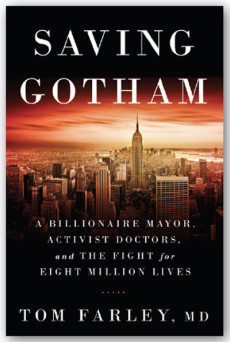
Saving Gotham: A Billionaire Mayor, Activist Donors, and the Fight for Eight Million Lives
Tom Farley
310 pages, W.W. Norton, 2015
In 2002, Michael Bloomberg was elected mayor of New York City. Over the course of three terms, he waged a war on the city’s carcinogenic and obesogenic environment. He hiked taxes on cigarettes, banned smoking in restaurants and bars, outlawed the use of trans fats in restaurants, forced food outlets to add calorie counts to menus, and almost (almost!) capped the size of soft-drink containers. He did so with the help of two health commissioners: Tom Frieden, who served until 2007, and Tom Farley, who stepped down in 2014.
Saving Gotham, written by Farley, is the story of how he and Frieden, along with the staff of the New York City Department of Health and Mental Hygiene, achieved those public policy changes. It’s the story of people who relied on data, persistence, and chutzpah to transform their traditionally staid department into an insurgent political machine. It’s the story of activist doctors who worked for a mayor with a strong interest in health—a mayor who also happened to be the 13th-richest person in the world.
Public health is the business of keeping people healthy. For centuries, that business focused on delivering services related to communicable diseases. But today, at least in middle- and high-income countries, the business of keeping people healthy is primarily about their lifestyle choices: what they eat, whether they exercise, and whether they smoke. Frieden and Farley, therefore, chose to frame their work in a radically different way. It would be less about delivering services than about “preventing needless deaths” that result from New York’s toxic environment.
Frieden and Farley judged the tobacco industry and some segments of the food industry to be purveyors of death, and they went after those industries with the righteous zeal of crusaders. When it comes to tobacco, that attitude seems to have merit. But the verdict on food is more complicated. Articles in respected medical journals, for instance, question whether high-salt diets are bad or posit that low-salt diets may be equally bad. Despite such nuances, Farley discusses such issues in a tone that says, “Trust us, we know best.” Farley seems trustworthy enough—but the underlying paternalism of his approach troubles me. The medical profession, after all, has a long history of abusing the trust of patients and communities.
In launching their ambitious campaigns, Frieden and Farley benefited from a peculiarity in how New York City manages public health. In the 19th century, the city established a Board of Health that enjoys considerable insulation from political pressure. The board maintains a health code, and the ability of the city health department to add regulations to that code is its most important tool. Although I applaud Frieden and Farley’s use of the code, I worry about the influence of a body that operates beyond the reach of democratic accountability. I also wonder how health departments that lack this organizational peculiarity can benefit from the lessons of this book.
There’s a touch of hubris in Saving Gotham that’s hard to tolerate at times. Farley clearly believes that other public health departments should follow the lead of his former department, but he gives scant attention to public health authorities whose lead New York City has followed. In 1993, Finland required food manufacturers to post high-salt warning labels. In 2001, Iceland passed a law that requires stores to keep cigarette packs out of view. In 2003, Denmark enacted a ban on trans fats. Although Farley mentions these precedents, he doesn’t offer enough detail to show whether he and his colleagues adopted, modified, or rejected the approaches of these other authorities. In any case, the achievements that Frieden and Farley oversaw are not unique to New York City.
Farley tells the story in two parts. The first part describes the period from 2002 to 2007 and relies on interviews with the main players, including Frieden. The second part, which covers his own tenure as health commissioner, has a more personal feel. At times the story is difficult to follow, because Farley jumps back and forth in time and between issues: smoking, trans fats, calorie-count labels. (A timeline of pivotal moments in the development of each issue would have been helpful.)
Along with recounting the history of his and Frieden’s work, Farley makes three provocative assertions. He unequivocally states that the US Food and Drug Administration (FDA) is under the thumb of food corporations—a serious charge, given that 80 percent of the salt that Americans consume reaches them through processed foods, which the FDA supposedly regulates. He openly suggests that Sam Kass, the personal chef to First Lady Michelle Obama and a senior policy advisor for nutrition in the White House, is under the influence of the food industry and is blocking the FDA’s attempts to regulate salt. And he accuses Michael Alderman, a doctor who opposes low-salt diets and a former advisor to the Salt Institute (a pro-salt lobby group), of misrepresenting the scientific case for limiting people’s salt intake. It’s all brave stuff.
Ultimately, though, Saving Gotham is about Michael Bloomberg. He appears in the book perhaps a dozen times, but his role as mayor, his desire for a legacy in health, and, quite frankly, his wealth empowered Frieden, Farley, and their teams to embrace a bold political strategy. It’s yet to be seen whether cities that don’t have a Bloomberg-like figure can replicate this approach. Which is all the more reason to place this story in the context of achievements elsewhere in the world.

